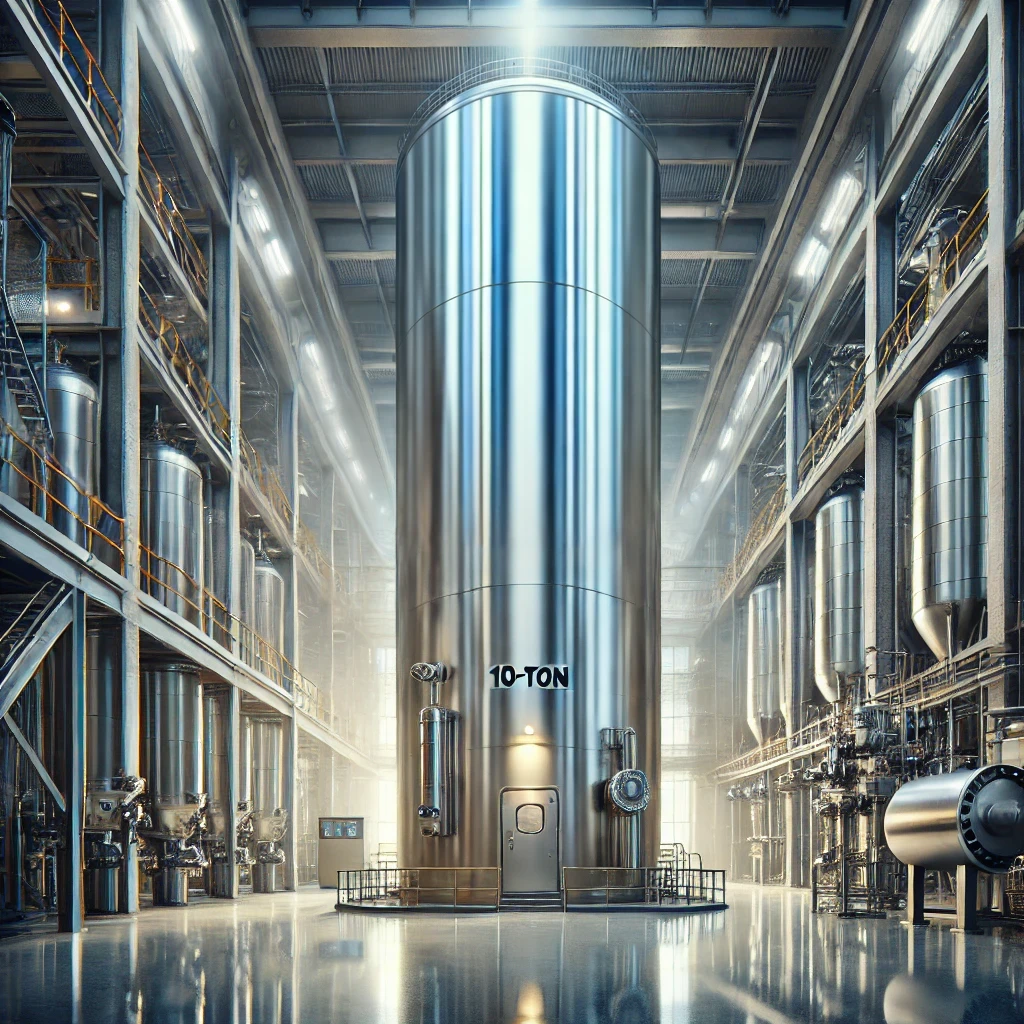Paslanmaz Tank Nedir?
Paslanmaz Tank Nedir?
Paslanmaz tanklar, özellikle endüstriyel ve ticari alanlarda sıvı ve kimyasal maddelerin güvenli bir şekilde depolanması için kullanılan dayanıklı tanklardır. Bu tanklar, paslanmaya ve korozyona karşı son derece dirençli olan paslanmaz çelik malzemeden üretilir. Sağlam yapısı, uzun ömürlü olması ve hijyenik özellikleri ile bilinirler.
Paslanmaz Tank Tanımı
Paslanmaz çelik, demir ve çelik alaşımına krom eklenmesiyle elde edilen ve paslanmaya karşı yüksek direnç sağlayan bir malzemedir. Paslanmaz tanklar ise bu özel çelikten üretilir ve içerdikleri sıvı veya katı maddelerin güvenli ve hijyenik bir şekilde saklanmasına olanak tanır.
Paslanmaz çelik, içeriğinde en az %10.5 oranında krom bulunan ve bu sayede kendiliğinden koruyucu bir oksit tabakası oluşturarak paslanma ve korozyona karşı korunan bir metal alaşımıdır. Bu özellik, paslanmaz tankların dayanıklılığını artırır ve onları birçok endüstriyel ve ev tipi uygulama için ideal hale getirir.
Paslanmaz Tankların Çeşitleri
Paslanmaz tanklar farklı kullanım alanlarına ve özelliklere göre sınıflandırılabilir. Endüstriyel paslanmaz tanklar, kimya ve petrol endüstrisi gibi ağır sanayilerde kullanılan büyük kapasiteli tanklardır. Ev tipi paslanmaz tanklar ise genellikle su depolama amaçlı kullanılan daha küçük boyutlu tanklardır. Ayrıca, su depolama tankları tarım alanında ve su arıtma tesislerinde kullanılmakta, kimyasal depolama tankları ise kimyasal maddelerin güvenli bir şekilde depolanması ve taşınması için özel olarak tasarlanmaktadır.
Paslanmaz Tankların Yapımında Kullanılan Malzemeler
Paslanmaz tankların üretiminde kullanılan çelik türleri, tankın dayanıklılığı ve korozyon direncini belirleyen en önemli faktörlerdir. 304 paslanmaz çelik, en yaygın kullanılan çelik türlerinden biridir ve genellikle gıda ile temas eden uygulamalarda tercih edilir. 316 paslanmaz çelik ise deniz suyu ve kimyasal ortamlarda daha fazla dayanıklılık gösterir ve daha yüksek korozyon direncine sahiptir.
Paslanmaz Tankların Avantajları
Paslanmaz tanklar birçok avantaj sunar. Korozyon direnci, dayanıklılık ve uzun ömür gibi özellikleri sayesinde diğer malzemelere göre daha fazla tercih edilirler. Paslanmaz çeliğin içeriğindeki krom, paslanmayı ve korozyonu önleyerek tankların uzun ömürlü olmasını sağlar. Çelik yapıları sayesinde mekanik hasarlara ve dış etkilere karşı son derece dayanıklıdırlar. Aynı zamanda pürüzsüz yüzeyleri sayesinde temizlenmesi ve bakımı oldukça kolaydır, bu da hijyenin önemli olduğu alanlarda büyük bir avantaj sağlar.
Paslanmaz Tankların Dezavantajları
Her ne kadar birçok avantaj sunsalar da, paslanmaz tankların bazı dezavantajları da bulunmaktadır. Paslanmaz çelik, diğer malzemelere göre daha pahalıdır ve bu da tankların üretim maliyetlerini artırır. Ayrıca, paslanmaz çelik tanklar oldukça ağır olabilir ve taşınması, kurulumu zor olabilir.
Paslanmaz Tankların Kullanım Alanları
Paslanmaz tankların kullanım alanları oldukça geniştir ve çeşitli endüstrilerde önemli bir rol oynarlar. Gıda ve içecek endüstrisinde, süt, meyve suyu, bira ve diğer sıvı gıdaların hijyenik koşullarda saklanması ve işlenmesi için kullanılır. Kimya sanayinde kimyasal maddelerin ve asitlerin güvenli bir şekilde depolanmasını sağlar. Su arıtma sistemlerinde temiz ve sağlıklı su depolama çözümleri sunar. Ayrıca ilaç üretiminde hassas bileşenlerin karıştırılması ve saklanmasında da kullanılır.
Paslanmaz Tankların Üretim Süreci
Paslanmaz tankların üretimi, çeşitli aşamalardan geçer ve yüksek kalite standartları gerektirir. Üretim süreci, tankın tasarım aşaması ile başlar. Kullanım amacına uygun boyut ve özellikler belirlenir. Daha sonra, kaynak, haddeleme ve yüzey işlemleri gibi tekniklerle tankın üretimi gerçekleştirilir. Üretilen tankların dayanıklılığı ve sızdırmazlık özellikleri test edilir.
Paslanmaz Tankların Bakım ve Temizliği
Paslanmaz tankların düzgün çalışabilmesi ve uzun ömürlü olması için düzenli bakım ve temizlik gereklidir. Tankın iç ve dış yüzeylerinin düzenli olarak kontrol edilmesi ve temizlenmesi gerekir. Özel paslanmaz çelik temizleyiciler ve hijyenik yöntemlerle temizlenmelidir. Tankın hijyenik olması, özellikle gıda ve ilaç endüstrisinde büyük önem taşır.
Paslanmaz Tank Seçerken Dikkat Edilmesi Gerekenler
Paslanmaz tank satın alırken dikkate alınması gereken bazı faktörler bulunmaktadır. Depolama ihtiyacınıza uygun kapasiteyi seçmek, tankın kurulacağı yerin özelliklerini göz önünde bulundurmak ve malzeme kalitesine dikkat etmek önemlidir. Çelik kalitesine dikkat edilmeli ve uzun ömürlü ürünler tercih edilmelidir.
Paslanmaz Tankların Çevresel ve Ekonomik Etkileri
Paslanmaz tanklar, sürdürülebilir ve çevre dostu çözümler sunar. Paslanmaz çelik geri dönüştürülebilir ve doğal kaynakları korur. Eski tanklar geri dönüştürülerek yeni ürünler üretilebilir, bu da çevreye olan etkilerini azaltır.
Paslanmaz Tank Fiyatlandırması
Paslanmaz tankların fiyatı, çeşitli faktörlere bağlı olarak değişir. Malzeme kalitesi, üretim süreci ve boyut gibi etkenler fiyatları doğrudan etkiler. Ancak, uzun vadede paslanmaz tankların dayanıklılığı ve uzun ömürlü yapısı, yatırım maliyetlerini karşılar ve ekonomik bir çözüm sunar.
Paslanmaz Tankların Diğer Depolama Çözümleriyle Karşılaştırılması
Paslanmaz tanklar, diğer depolama çözümleriyle karşılaştırıldığında birçok avantaj sunar. Plastik tanklara göre daha dayanıklı ve hijyeniktirler, beton tanklara göre ise daha uzun ömürlü ve geri dönüştürülebilir özelliklere sahiptirler. Gelişen teknoloji ile birlikte paslanmaz tankların üretim süreçleri de değişiyor ve daha dayanıklı ve hafif tanklar üretiliyor.
Paslanmaz Tankların Geleceği ve Teknolojik Gelişmeler
Teknoloji geliştikçe paslanmaz tankların üretim süreçleri de değişiyor. Yeni üretim teknikleri sayesinde daha dayanıklı ve hafif tanklar üretilebiliyor. Ayrıca, IoT tabanlı çözümlerle paslanmaz tanklar uzaktan izlenebilir hale geliyor ve akıllı depolama sistemleriyle entegre edilebiliyor.
Paslanmaz Tankların Türkiye’deki Durumu
Türkiye’de paslanmaz tanklar giderek daha fazla kullanılmaktadır. Türkiye’de yerli üretim yapan firmalar bulunmakta ve aynı zamanda ithal ürünlere de talep artmaktadır. Özellikle sanayi ve tarım sektöründe paslanmaz tanklar yaygın olarak tercih edilmektedir.
Daha Fazla Detaylı Bilgi İçin Ürünlerimizi İnceleyebilirsiniz!
Paslanmaz tanklar genellikle 20-30 yıl gibi uzun bir ömre sahiptirler, ancak bakım ve kullanıma bağlı olarak bu süre uzayabilir.
Paslanmaz çelik malzemenin yüksek maliyeti ve dayanıklılığı, bu tankların üretim fiyatlarını artırmaktadır.
Gıda, içecek, kimya, ilaç ve su arıtma sektörlerinde yaygın olarak kullanılırlar.
Hayır, paslanmaz tanklar genellikle bakım gerektirmez ve düzenli temizlikle uzun süre hijyenik kalabilir.
Evet, paslanmaz çelik tamamen geri dönüştürülebilir ve çevre dostu bir malzemedir.
Kullanım amacınıza uygun kapasite, malzeme kalitesi ve üretici garantisi gibi unsurlara dikkat edilmelidir.


